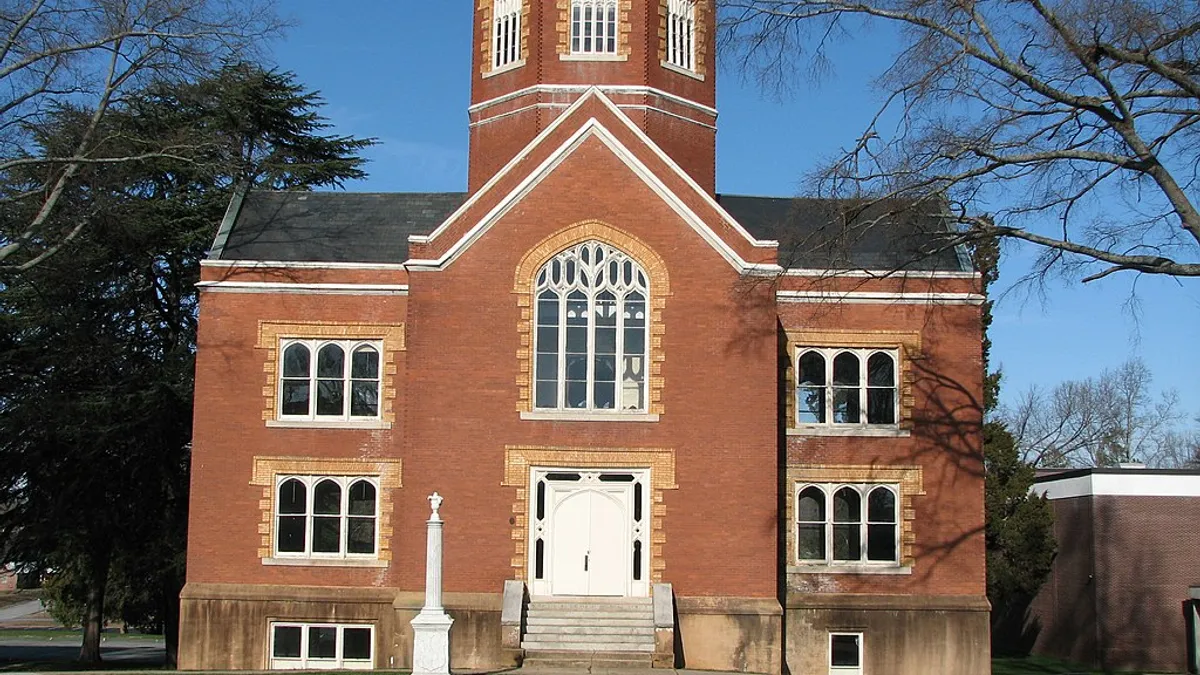Last week Higher Ed Dive published the first of a two-part conversation with Evan Mandery, author of the book "Poison Ivy: How Elite Colleges Divide Us."
Mandary graduated from Harvard University. Today, he's a professor at John Jay College of Criminal Justice, which is part of the City University of New York system. He's become one of the leading critics of Ivy League and other super-wealthy universities.
Wealthy institutions, particularly those with endowments exceeding $1 billion, have a special obligation, he argues: "Actually do good."
His broader case is that these institutions do more to keep rich people rich than to boost socioeconomic mobility or pursue any other greater good. All higher ed leaders may not agree with his stance. But at a time when the public sharply questions the value of higher education, and when trust in institutions of all types is plummeting, it's worth understanding.
Here's the remainder of the conversation.
This interview has been edited for clarity and brevity.
HIGHER ED DIVE: You don't seem to think there's a silver bullet that will solve all of your criticisms. But should Ivy League colleges simply admit more students?

EVAN MANDERY: I think you're right to start there. It's the simplest, most politically tenable solution, and it's the most conspicuous that it hasn't happened.
Part of Harvard's resistance to changing the status quo, or their indignant commitment to continuing affirmative action for rich Whites, is — they're not going to say this, but it's obvious — they don't want to unsettle the relationships they have with Groton and Andover and Exeter and 50 club lacrosse programs.
But increasing the capacity would be a very easy way to maintain those relationships. It could be potentially transformative for communities.
Imagine a Harvard Detroit. Are they really so worried it would damage their brand? I'm very, very dubious that it would.
How many students should they add?
Doubling capacity with an aim of dramatically increasing overall socioeconomic diversity feels to me like something they could do.
Would that make a difference? Well, it would make a difference for the 6,000 undergraduates — or 1,500 undergraduates per year — that they admitted.
There's no single response to this. Every life matters. But, you know, collectively, let's say 1,500 students per year, eight colleges. You're talking 12,000 to 15,000 students per cohort, 150,000 over the course of a decade.
That feels like a real difference to me. It ain't nothing.
What would have to happen for such an expansion to be executed in a just way, in your eyes?
I've always focused on starting by ending unjust practices. So, obviously, legacy and preference for donors and alumni children is utterly indefensible. There is nobody who is not an administrator at one of these colleges who defends one of these practices.
You mention how many tax breaks these institutions receive. But something very interesting happened during the Trump administration: Republicans passed a tax on net investment income at colleges with large endowments.
Trump did a 1.4% excise tax. It was a rounding error for these colleges, and it was just punitive of elites who are the college-educated elites who obviously didn't vote for him.
So the next Republican administration could just tax colleges with endowments over a certain level more highly. Then poor kids would have nothing to show for it, as they have nothing to show for what Trump did.
Or the left can say, "Hey, you've been getting a free pass for so long, here's a list of goals you can commit yourself to. You need to show meaningful progress toward one or more of these in order to get this benefit."
It's going to come from the left or the right or both, and the question is whether or not the tax break is going to be leveraged to do some good for socioeconomically disadvantaged kids or whether it is just going to be punitive.
Your book references the money Michael Bloomberg gave to Johns Hopkins University, saying something to the effect of, "Imagine what a CUNY college could do with this."
I argue that Mike Bloomberg's gift, like David Geffen building a new New York Philharmonic Hall, is generous and not just — especially in the case of Johns Hopkins, because it exacerbates the divide between the haves and have-nots.
It's very hard for people to have a sense of big numbers. One thing I ask in the book is, what does it look like if Harvard increases its draw on its endowment [by a percentage point]? That's an extra $500 million.
What does $500 million a year do in America? Well, John Jay, my college, costs about $200 million a year to run. We have about 12,000 students enrolled, and 60% of CUNY students come from families in need.
Imagine if Harvard loosely partnered with Bunker Hill Community College, and they said, "We're going to start admitting the top 20 kids from your graduating class every year, and we're going to invest in this community college. We're going to send some of our professors to teach there and some of our graduate students to be adjuncts there."
You'd transform the institution with a meaningful commitment to access.
The contrast between endowment spending and what it costs to run John Jay is powerful. What if you spent the money in parts of the country with lower costs than the Northeast?
That money would go a lot further if it were spent in a socioeconomically disadvantaged community. There are tons of positive externalities to actually building a campus.
What I wish somebody like Mike Bloomberg did with their billion dollars is say, "Hey, we're going to actually go and build a campus for you in the center of Detroit, and now you can draw a little bit more down on our endowment and use that to fund your operating costs. But I'll fund the fixed costs."
That would be just giving.
If you expand these institutions like that, are you worried you'll just end up with them graduating more investment bankers?
If there was a meaningful increase of socioeconomic access, I would feel better about students growing up to be investment bankers. And I think Goldman Sachs would look a lot different if the management committee were filled with people who grew up poor, as opposed to third-generation wealth.
It's not ideal, but I actually think it would be a significant improvement.
I'm not so blind that I think that elite college is the only bad actor. So, obviously, Goldman Sachs and McKinsey could take it upon themselves to diversify pathways to being consultants or analysts. And they choose not to do that.
In the book I describe extreme residential segregation in America. These communities could take it upon themselves to bring kids from more socioeconomically disadvantaged districts into their wealthier districts. These things could happen, and they should happen.
The reason I'm a little bit more optimistic about the prospect for change is elite colleges have the capacity to do this. Look, they are filled with people who are ostensibly responsive to data.
People get very, very protective when it comes to the interest of their own kids, so I think it's very, very hard to imagine meaningful change in suburban communities. But I don't think anybody reading my book will leave not believing that elite colleges have to do significantly more than they're doing.
We should mention that wealthy students are very attractive to other types of colleges as well. Non-wealthy colleges use enrollment management techniques to bring in enough tuition revenue to balance their budgets. In some cases, a few students who pay full tuition can swing you from annual losses to surpluses.
So should we view this as a larger, system-wide problem?
It's worth mentioning. I briefly discuss enrollment managers in the book in the context of the U.S. News & World Report rankings.
I think an institution with a half-billion-dollar endowment is different in kind from an institution with a $50 million endowment.
And I'm sympathetic to a Bucknell or wherever using an enrollment manager. I'm not so sympathetic to Princeton using an enrollment manager.
I see a discontinuity between those two types of institutions. What the precise point of discontinuity is, I can't say specifically. All I know is when the earnings of your endowment exceed the cost of the undergraduates per year, you clearly have enough.
What's the Supreme Court justice quote — I know it when I see it?
It's the obscenity definition from Harry Blackmun.
What didn't we talk about that we should have discussed?
I think my book has plenty of policy, but it's mostly a story about human beings who persevere against the odds and overcome insurmountable obstacles. I hope that people do see what extraordinary engines of opportunity the City University of New York and public colleges are.
My other significant contribution is to show the synergies, negative synergies, between elite colleges and suburbs. I think they work hand-in-hand to drive de facto segregation in America.






















